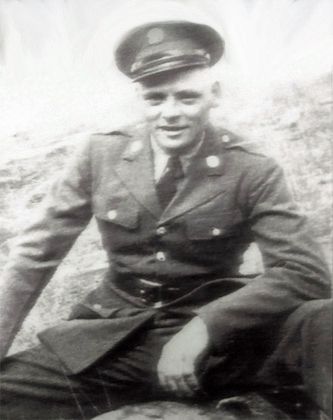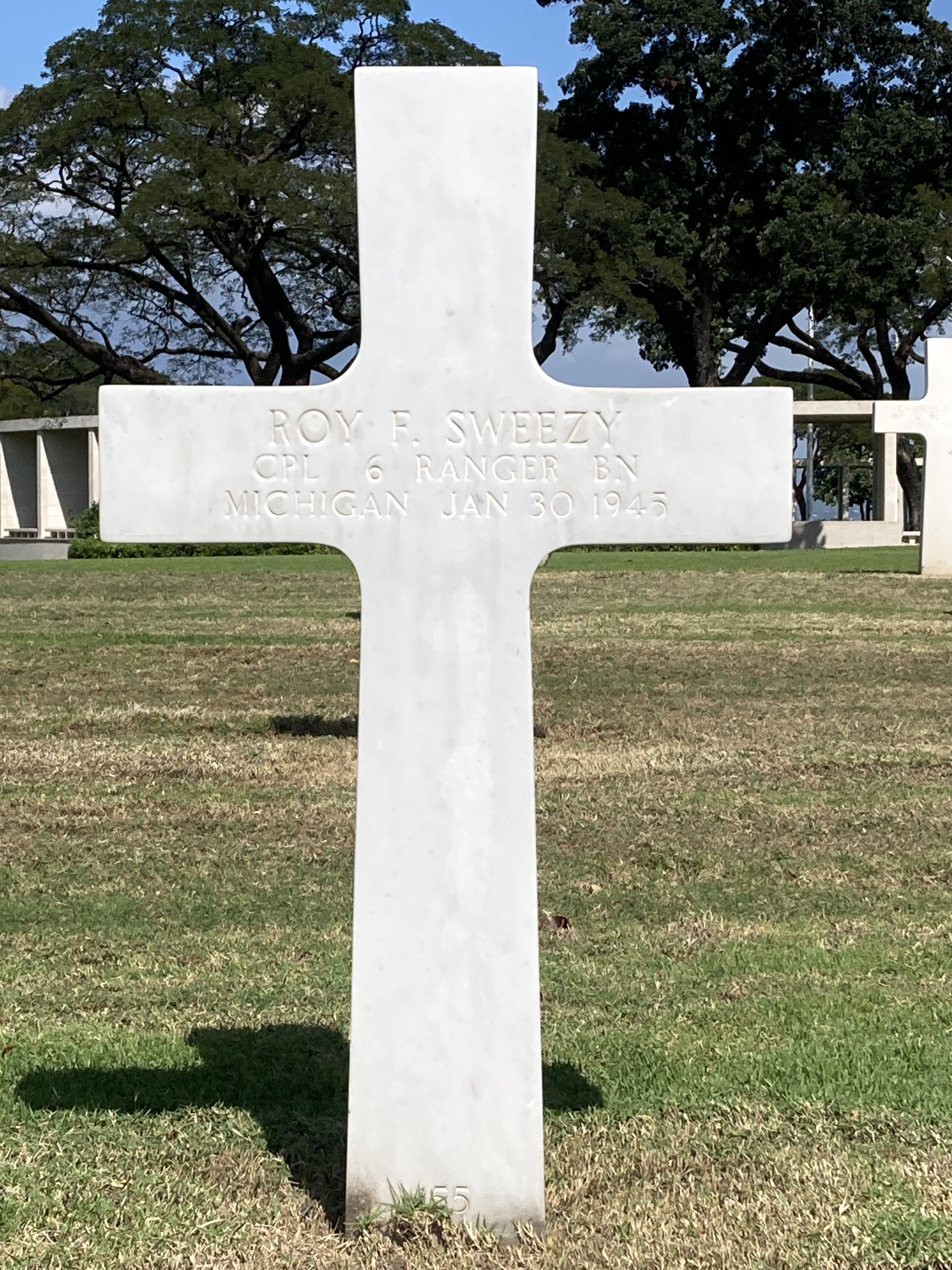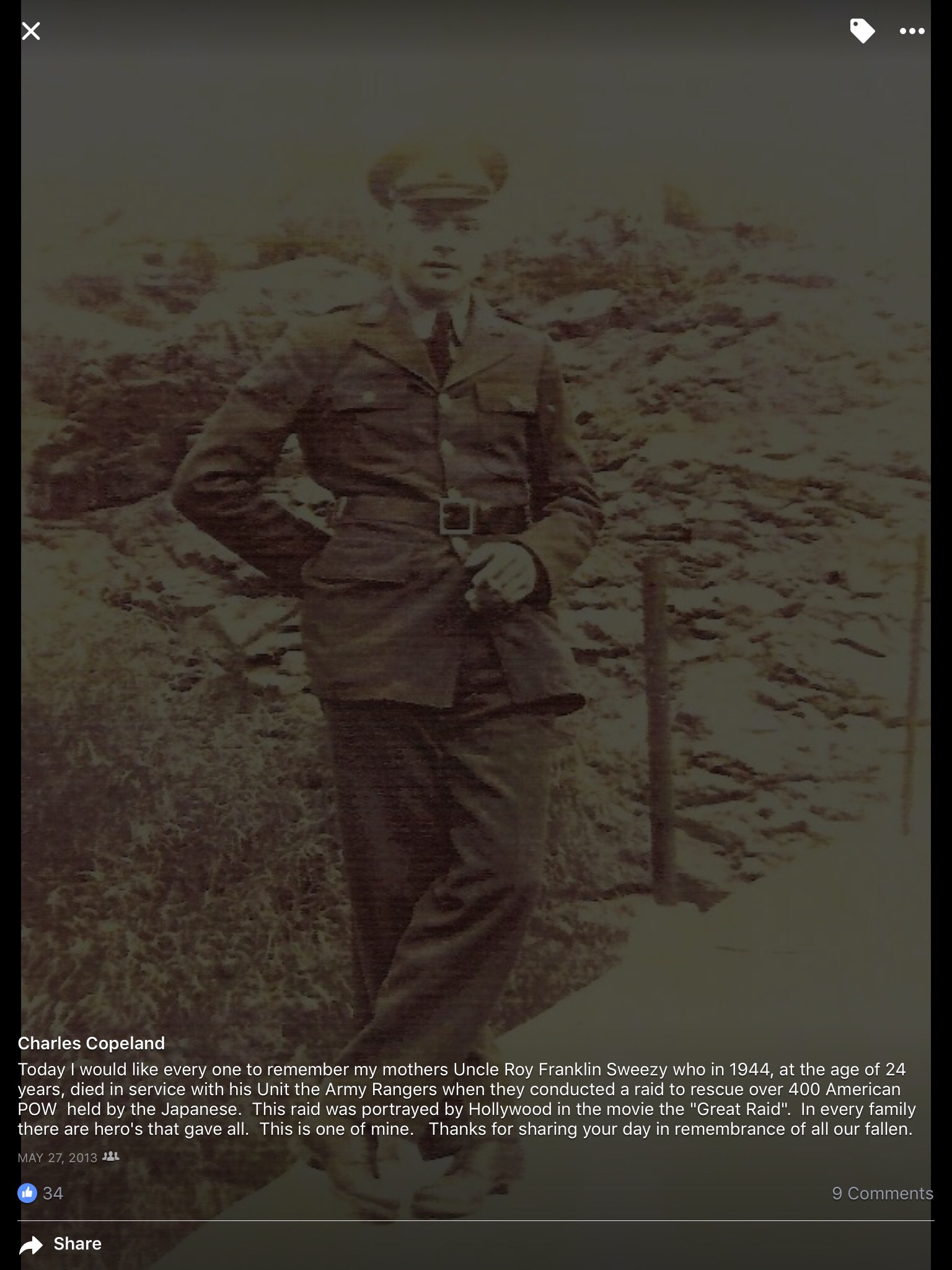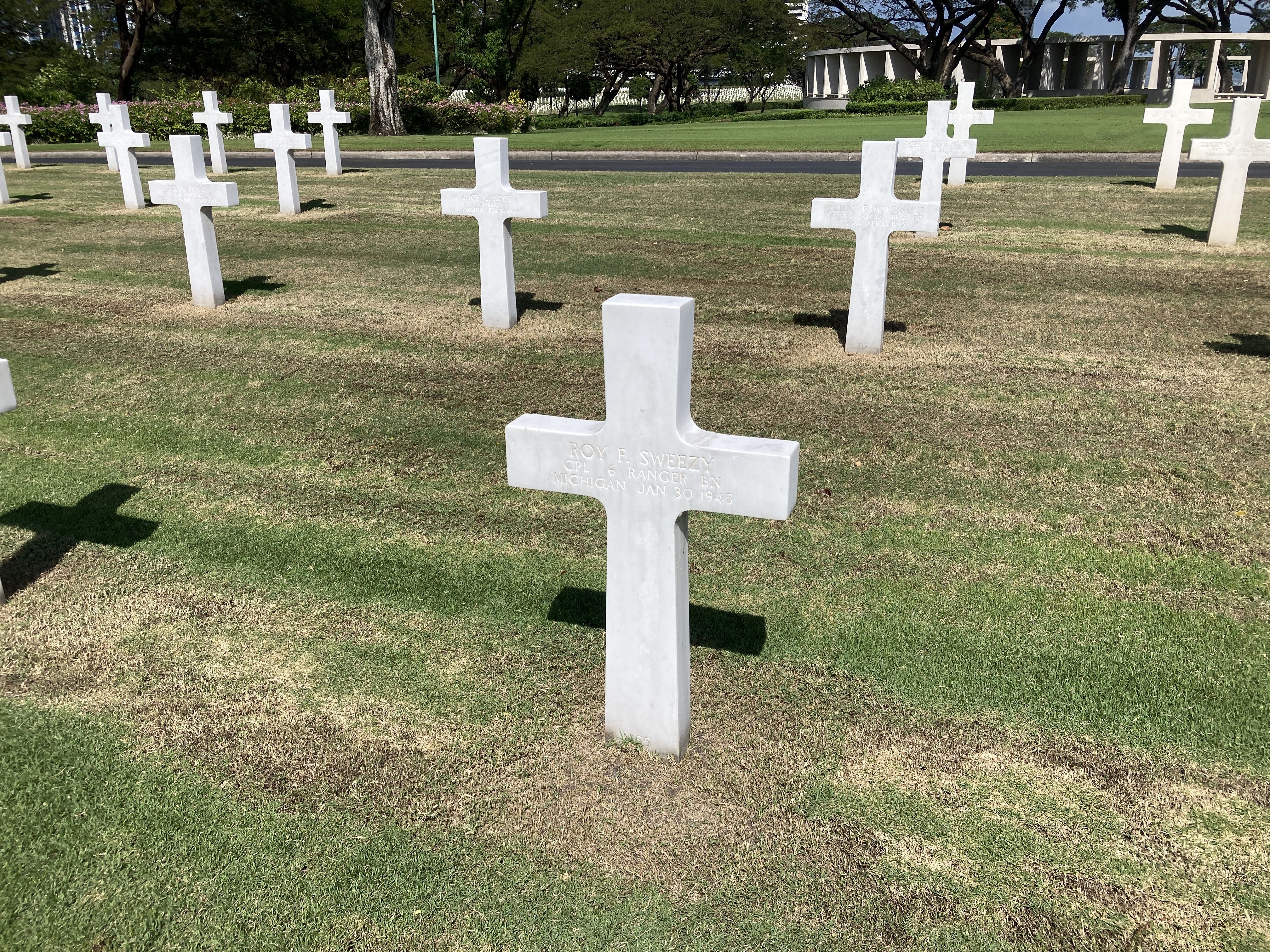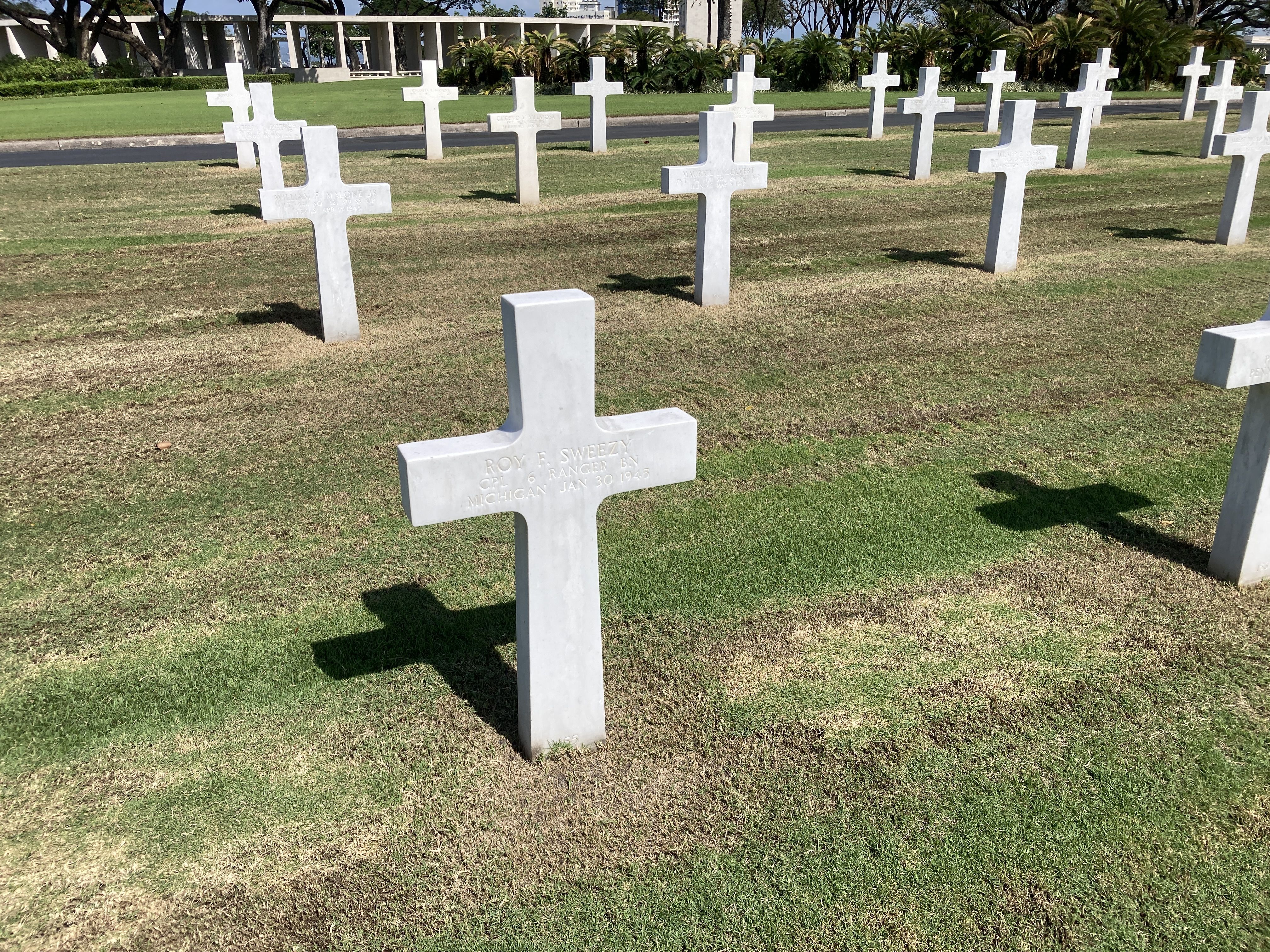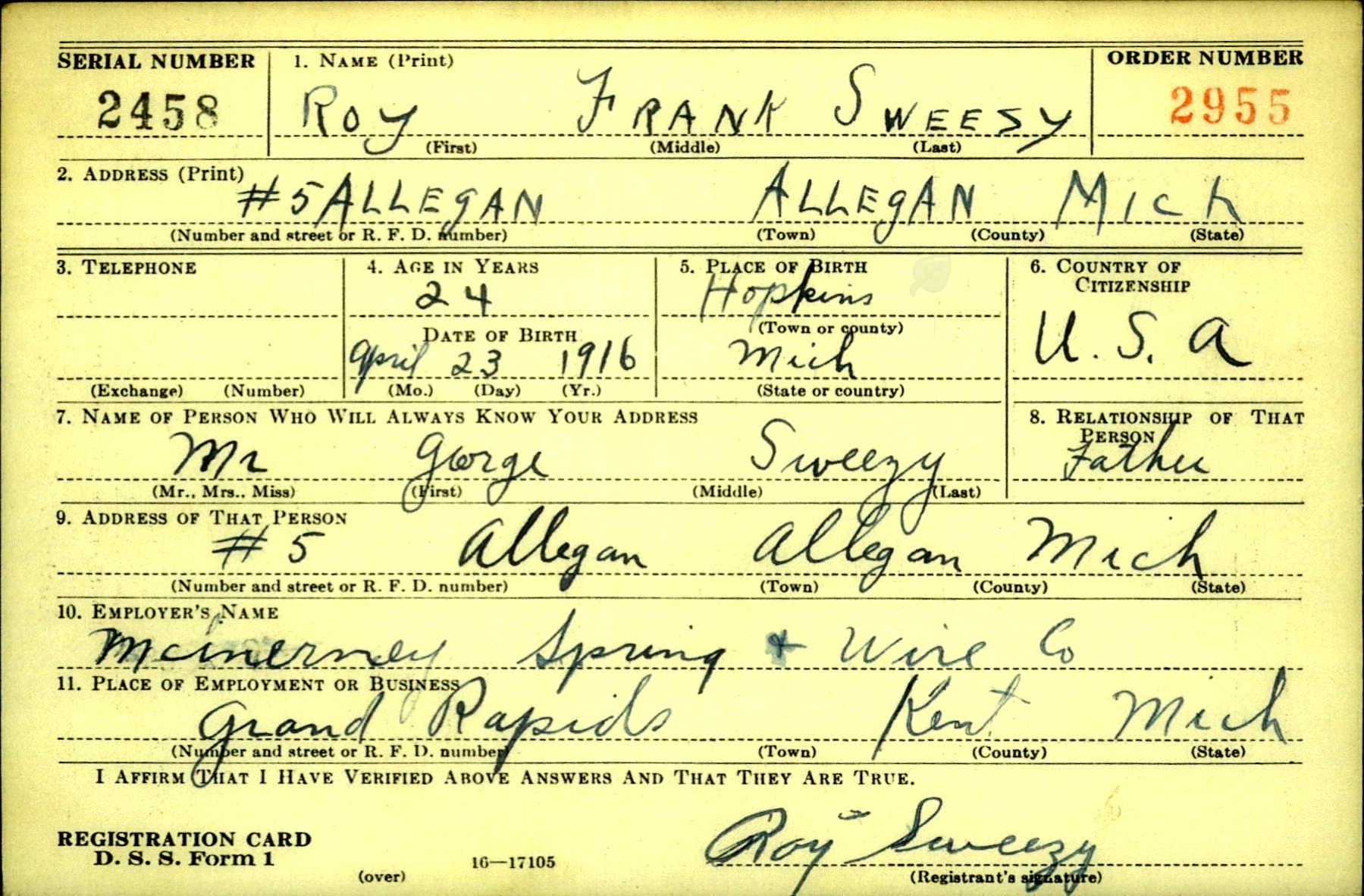Service #: 36159754
Entered the Service from: Michigan
Rank: Corporal, U.S. Army
Unit: 2nd Platoon, Company F, 6th Ranger Battalion
Date of Death: 30 January 1945, Cabanatuan, Nueva Ecija Province, Luzon, Philippines
Buried at: Manila American Cemetery – Plot A, Row 4, Grave 155
Awards: Bronze Star, Purple Heart
~~~~~~~~~~~~~~~~~~~~~~~~~~~~~~~~~~~~~~~~~~~~~~~~~~~~~~~~~~~~~~~~~~~~~~~~~~~~~~~~~~~~~
1920 United States Federal Census (15 January 1920): Monterey Township, Allegan County, Michigan (sheet 5A, family 114) – Roy F. Sweezy (3 5/12 Michigan)
1930 United States Federal Census (10 April 1930): Monterey Township, Allegan County, Michigan (sheet 5B, family 112) – Roy F. Sweezy (13 Michigan)
1940 United States Federal Census (15 May 1940): Monterey Township, Allegan County, Michigan (sheet 6B, household 145) – Roy Sweezy (24 Michigan). His family had lived in the same place in 1935. Roy had completed 8th grade.
Roy Frank Sweezy (24, 23 April 1916, Hopkins, Michigan), a resident of #5, Allegan, Allegan County, Michigan, signed up for his World War II Draft Registration Card (Serial No. 24581, Order No. 2955) on 16 October 1940 at Allegan, Allegan County, Michigan. He was employed by McInerney Spring and Wire Company in Grand Rapids, Michigan. Roy listed his father, Mr. George Sweezy, as the person who would always know his address. He was described as 6' in height, 170 lbs., with a light complexion, brown hair and grayl eyes.
Roy F. Sweezy (1916 Michigan), enlisted as a Private (S/N 36159754) in the U.S. Army on 15 September 1941 in Kalamazoo, Michigan. His enlistment was for three years. Roy was single, had completed Grammar School and had been working as "semiskilled welders and flame cutters."
Private Roy F. Sweezy was assigned to the 98th Field Artillery Battalion.
"The 98th Field Artillery Battalion was a regular army mule pack artillery unit stationed in Camp Carson, Colorado in 1942. The unit consisted of three firing batteries plus headquarters and service battery. The unit had the 75 millimeter howitzer for fire power and nearly 1000 men and 800 mules. On 13 December, 1942 the unit was sent to Camp Patrick Henry, Virginia via rail to a staging area for overseas debarkation. Soon thereafter, the mules were sent to a port in San Francisco to be loaded on an animal ship for overseas destination. The 98th arrived at Camp Patrick Henry on 31 Jan 1943 after a two day stop going through the Panama Canal. A tent camp was set up at the edge of Brisbane awaiting the arrival of the mules. However, the Australian government refused to allow the mules to enter the country due to a law forbidding the importation of foreign animals. So, on the 9 February 1943, the unit was sent to New Guinea via Liberty ship. They arrived on the 17th of February and set up a tent camp about 20 miles from Port Moresby. The mules arrived a few days later. For the next year it was training, but no action and 6th Army decided the unit was obsolete."
The 6th Ranger Infantry Battalion was formed 25 September 1944 from men of the 98th Field Artillery Battalion. The new battalion commander, LTC Henry "Hank" Mucci, "informed the battalion that it was being converted to Rangers and a large turn over of personnel began. He was brilliant as a leader, but demanded the best from all his men "or out you went". The Rangers only needed 500 men, so half were sent out very soon after training began." Source: https://wwiirangers.org/our-history/ranger-history/6th-btn/
Roy F. Sweezy became a BAR man for 2nd Platoon, Company F, 6th Ranger Battalion.
By 1 July 1944, the battalion had pretty well completed the necessary training, so they were sent to Finchhaven where the unit was reorganized into six rifle companies, headquarters and service company.
Philippines Campaign
The 6th Rangers were to lead the invasion of the Philippines. The battalion left Finschhafen, New Guinea for Leyte in the Philippines on 10 October 1944. It was to secure the islands of Dinagat, Homonhon and Suluan, located in the entrance to Leyte Gulf. These islands had the potential to disrupt Sixth Army's landing operations if they remained in Japanese hands. After initial delays due to bad weather, the operation went ahead on 18 October, and was a success. The 6th Rangers on Dinagat raised the first American flag on Philippine soil as part of General Douglas MacArthur's "Return to the Philippines".
After the success of this mission, the invasion of Leyte got underway on 20 October 1944. The 6th Rangers were moved to Tacloban on Leyte, where they were mostly used for patrolling actions. Late in the year, the order came through for the battalion to prepare to take part in the landings in Lingayen Gulf, which were to form the invasion of Luzon. On 1 January 1945, the Rangers were transported by sea from Tacloban to Lingayen Gulf, and were landed on Lingayen Gulf Beach on 10 January 1945. Elements of the battalion were sent to Santiago Island to secure the entrance to the Gulf and prevent the enemy outflanking the landing area.
Sixth Army Intelligence indicated that the Japanese were holding a large number of American POWs in Cabanatuan, 60 miles north of Manila. Reports of the Palawan POW Camp Massacre led intelligence to believe that the POWs would be executed as the Imperial Japanese Army retreated. General Walter Krueger, Sixth Army commander, ordered 6th Rangers to "bring the prisoners out alive".
C Company, under Capt. Robert Prince, reinforced with a platoon from F Company and accompanied by Lt. Col. Mucci, was to undertake the mission (124 men). Alamo Scouts (13 men) and Filipino guerrillas (300–350 men) accompanied the 6th Ranger force, and provided reconnaissance and flank protection. The attack went ahead at dusk on 30 January. During the battle, the Rangers rescued 516 POWs. Source: Wikipedia
To read more about the "Great Raid" go to: https://arsof-history.org/articles/v14n2_cabanatuan_page_1.html
Corporal Roy F. Sweezy was killed 30 January 1945 by friendly fire during the 6th Ranger raid on the POW camp at Cabanatuan that rescued the prisoners.
"Six men from Company F were the last Americans to withdraw from the objective, and as they did so, the Japanese brought them under fire. The six were trotting along the outside of the compound fence toward the highway when they began receiving scattered rifle shots. Some of the Rangers fired back, while others dashed through the moonlight toward the drainage ditch they had come through during their approach. When Corporal Roy Sweezy turned to fire his M-l at the Japanese, he was shot through the chest with an automatic weapon and died several minutes later. He and the fatally wounded Captain James C. Fisher were the only Rangers to die in the operation." Source: Rangers: Selected Combat Operations in World War II by Dr. Michael J. King June 1985, page 69
~~~~~~~~~~~~~~~~~~~~~~~~~~~~~~~~~~~~~~~~~~~~~~~~~~~~~~~~~~~~~~~~~~~~~~~~~~~~~~~~~~~~~
Interview with Francis R. Schilli found in the Daily Journal, Park Hills, MO, published Aug 15, 2005
The "mission was to travel almost 33 miles in four days behind Japanese lines. They were to bring back alive more than 500 prisoners of war held in a hellish camp deep in the jungles and rice paddies of Luzon. Among these POWs, barely able to hold onto life, were some of the last survivors of the infamous Bataan Death March, men who had been captured in 1942 on Bataan and Corregidor.
A Japanese soldier had gotten to a knee mortar and starting firing it. The first shell hit near the gate and wounded the company doctor (Captain James C. Fisher). He would later die of those wounds. Several other Americans were hit by flying shrapnel from the shell. Schilli and Sweezy quickly moved into the area of the mortar and sent blasts of gun fire toward the mortar position. "We hit him right away and silenced the mortar," Schilli said. The battle raged for a little more than a half hour. "They shot off a red flare and it meant we were to pull out. I was fighting the rear guard and was about the last man to leave the camp area," he said.
The Loss of a Friend
It was then the darkest part of the raid took place for Schilli. "We ran down through the rice field and jumped into a ditch. It was about that deep in mud and water," he said holding his hand about two feet off the floor. "Someone yelled 'Where is Roy?' and I said 'He's right behind me!' "I looked around and saw him standing on the top of the ditch. "I can still see him there," he said, as his mind flashed back nearly 58 years. "There was shooting from behind us. We turned and fired back. We must have hit them because it stopped. Roy and I stood up. Then a few feet away I saw the flash of a gun and Roy fell. "The fire came from one of our own men. He was nervous and I guess when we stood up he just fired out of reaction. I was about a foot away from Sweezy when he was hit. It could have been me. "It was clear Roy was not going to live, but I made up my mind he was not going to die without being baptized. The other guys agreed and I poured some water over his head and said a prayer. The other guys said some prayers ... I don't know what faith they were," Schilli, himself a devoted Catholic, remembered. You could see that even after nearly six decades, the loss of his friend still hurt him deeply.
The others took off, but Schilli stayed with his friend not wanting to leave him there for the Japanese. "There were a couple of Filipinos there. I asked them if they would get him out of there and they said they would. "That's the last time I saw him. I never knew what happened to him, that is until a few years ago when I saw a photo of a grave stone there with his name on it in a cemetery. I guess they kept their word and brought him out," Schilli said, still deeply troubled, but with some closure knowing his buddy had come back."
~~~~~~~~~~~~~~~~~~~~~~~~~~~~~~~~~~~~~~~~~~~~~~~~~~~~~~~~~~~~~~~~~~~~~~~~~~~~~~~~~~~~~
[Narrator]: Ranger Corporal Roy Sweezy was shot not by the Japanese but by "friendly fire".
[Francis Schill, 6th Ranger Battalion]: I jumped out and crawled over to where Sweezy was. I put my arm under his head. I got my canteen out, poured water on his head, and give him the blessing -- "in the name of the Father and the Son of the Holy Spirit, Amen, I baptize you" and so on. And the last thing Sweezy said was "One of my own men killed me!"
He was first buried in 7749 USAF Cemetery, Santa Barbara #1, Philippine Islands – Row 37, Grave 1937. After the war (during the fall 1947) his remains (along with 5,195 other American soldiers) were disinterred and brought to the American Graves Registration Service Manila Mausoleum. From there, according to the wishes of his next of kin (mother, Mrs. Carrie C. Sweezy), Corporal Roy Franklin Sweezy was buried in his final resting place in the 7701 Ft. McKinley Cemetery (now known as the Manila American Cemetery) – Plot A, Row 4, Grave 155.
The 6th Ranger raid on Cabanatuan has been the subject of several books and the movie, "The Great Raid."
Service #: 36159754
Entered the Service from: Michigan
Rank: Corporal, U.S. Army
Unit: 2nd Platoon, Company F, 6th Ranger Battalion
Date of Death: 30 January 1945, Cabanatuan, Nueva Ecija Province, Luzon, Philippines
Buried at: Manila American Cemetery – Plot A, Row 4, Grave 155
Awards: Bronze Star, Purple Heart
~~~~~~~~~~~~~~~~~~~~~~~~~~~~~~~~~~~~~~~~~~~~~~~~~~~~~~~~~~~~~~~~~~~~~~~~~~~~~~~~~~~~~
1920 United States Federal Census (15 January 1920): Monterey Township, Allegan County, Michigan (sheet 5A, family 114) – Roy F. Sweezy (3 5/12 Michigan)
1930 United States Federal Census (10 April 1930): Monterey Township, Allegan County, Michigan (sheet 5B, family 112) – Roy F. Sweezy (13 Michigan)
1940 United States Federal Census (15 May 1940): Monterey Township, Allegan County, Michigan (sheet 6B, household 145) – Roy Sweezy (24 Michigan). His family had lived in the same place in 1935. Roy had completed 8th grade.
Roy Frank Sweezy (24, 23 April 1916, Hopkins, Michigan), a resident of #5, Allegan, Allegan County, Michigan, signed up for his World War II Draft Registration Card (Serial No. 24581, Order No. 2955) on 16 October 1940 at Allegan, Allegan County, Michigan. He was employed by McInerney Spring and Wire Company in Grand Rapids, Michigan. Roy listed his father, Mr. George Sweezy, as the person who would always know his address. He was described as 6' in height, 170 lbs., with a light complexion, brown hair and grayl eyes.
Roy F. Sweezy (1916 Michigan), enlisted as a Private (S/N 36159754) in the U.S. Army on 15 September 1941 in Kalamazoo, Michigan. His enlistment was for three years. Roy was single, had completed Grammar School and had been working as "semiskilled welders and flame cutters."
Private Roy F. Sweezy was assigned to the 98th Field Artillery Battalion.
"The 98th Field Artillery Battalion was a regular army mule pack artillery unit stationed in Camp Carson, Colorado in 1942. The unit consisted of three firing batteries plus headquarters and service battery. The unit had the 75 millimeter howitzer for fire power and nearly 1000 men and 800 mules. On 13 December, 1942 the unit was sent to Camp Patrick Henry, Virginia via rail to a staging area for overseas debarkation. Soon thereafter, the mules were sent to a port in San Francisco to be loaded on an animal ship for overseas destination. The 98th arrived at Camp Patrick Henry on 31 Jan 1943 after a two day stop going through the Panama Canal. A tent camp was set up at the edge of Brisbane awaiting the arrival of the mules. However, the Australian government refused to allow the mules to enter the country due to a law forbidding the importation of foreign animals. So, on the 9 February 1943, the unit was sent to New Guinea via Liberty ship. They arrived on the 17th of February and set up a tent camp about 20 miles from Port Moresby. The mules arrived a few days later. For the next year it was training, but no action and 6th Army decided the unit was obsolete."
The 6th Ranger Infantry Battalion was formed 25 September 1944 from men of the 98th Field Artillery Battalion. The new battalion commander, LTC Henry "Hank" Mucci, "informed the battalion that it was being converted to Rangers and a large turn over of personnel began. He was brilliant as a leader, but demanded the best from all his men "or out you went". The Rangers only needed 500 men, so half were sent out very soon after training began." Source: https://wwiirangers.org/our-history/ranger-history/6th-btn/
Roy F. Sweezy became a BAR man for 2nd Platoon, Company F, 6th Ranger Battalion.
By 1 July 1944, the battalion had pretty well completed the necessary training, so they were sent to Finchhaven where the unit was reorganized into six rifle companies, headquarters and service company.
Philippines Campaign
The 6th Rangers were to lead the invasion of the Philippines. The battalion left Finschhafen, New Guinea for Leyte in the Philippines on 10 October 1944. It was to secure the islands of Dinagat, Homonhon and Suluan, located in the entrance to Leyte Gulf. These islands had the potential to disrupt Sixth Army's landing operations if they remained in Japanese hands. After initial delays due to bad weather, the operation went ahead on 18 October, and was a success. The 6th Rangers on Dinagat raised the first American flag on Philippine soil as part of General Douglas MacArthur's "Return to the Philippines".
After the success of this mission, the invasion of Leyte got underway on 20 October 1944. The 6th Rangers were moved to Tacloban on Leyte, where they were mostly used for patrolling actions. Late in the year, the order came through for the battalion to prepare to take part in the landings in Lingayen Gulf, which were to form the invasion of Luzon. On 1 January 1945, the Rangers were transported by sea from Tacloban to Lingayen Gulf, and were landed on Lingayen Gulf Beach on 10 January 1945. Elements of the battalion were sent to Santiago Island to secure the entrance to the Gulf and prevent the enemy outflanking the landing area.
Sixth Army Intelligence indicated that the Japanese were holding a large number of American POWs in Cabanatuan, 60 miles north of Manila. Reports of the Palawan POW Camp Massacre led intelligence to believe that the POWs would be executed as the Imperial Japanese Army retreated. General Walter Krueger, Sixth Army commander, ordered 6th Rangers to "bring the prisoners out alive".
C Company, under Capt. Robert Prince, reinforced with a platoon from F Company and accompanied by Lt. Col. Mucci, was to undertake the mission (124 men). Alamo Scouts (13 men) and Filipino guerrillas (300–350 men) accompanied the 6th Ranger force, and provided reconnaissance and flank protection. The attack went ahead at dusk on 30 January. During the battle, the Rangers rescued 516 POWs. Source: Wikipedia
To read more about the "Great Raid" go to: https://arsof-history.org/articles/v14n2_cabanatuan_page_1.html
Corporal Roy F. Sweezy was killed 30 January 1945 by friendly fire during the 6th Ranger raid on the POW camp at Cabanatuan that rescued the prisoners.
"Six men from Company F were the last Americans to withdraw from the objective, and as they did so, the Japanese brought them under fire. The six were trotting along the outside of the compound fence toward the highway when they began receiving scattered rifle shots. Some of the Rangers fired back, while others dashed through the moonlight toward the drainage ditch they had come through during their approach. When Corporal Roy Sweezy turned to fire his M-l at the Japanese, he was shot through the chest with an automatic weapon and died several minutes later. He and the fatally wounded Captain James C. Fisher were the only Rangers to die in the operation." Source: Rangers: Selected Combat Operations in World War II by Dr. Michael J. King June 1985, page 69
~~~~~~~~~~~~~~~~~~~~~~~~~~~~~~~~~~~~~~~~~~~~~~~~~~~~~~~~~~~~~~~~~~~~~~~~~~~~~~~~~~~~~
Interview with Francis R. Schilli found in the Daily Journal, Park Hills, MO, published Aug 15, 2005
The "mission was to travel almost 33 miles in four days behind Japanese lines. They were to bring back alive more than 500 prisoners of war held in a hellish camp deep in the jungles and rice paddies of Luzon. Among these POWs, barely able to hold onto life, were some of the last survivors of the infamous Bataan Death March, men who had been captured in 1942 on Bataan and Corregidor.
A Japanese soldier had gotten to a knee mortar and starting firing it. The first shell hit near the gate and wounded the company doctor (Captain James C. Fisher). He would later die of those wounds. Several other Americans were hit by flying shrapnel from the shell. Schilli and Sweezy quickly moved into the area of the mortar and sent blasts of gun fire toward the mortar position. "We hit him right away and silenced the mortar," Schilli said. The battle raged for a little more than a half hour. "They shot off a red flare and it meant we were to pull out. I was fighting the rear guard and was about the last man to leave the camp area," he said.
The Loss of a Friend
It was then the darkest part of the raid took place for Schilli. "We ran down through the rice field and jumped into a ditch. It was about that deep in mud and water," he said holding his hand about two feet off the floor. "Someone yelled 'Where is Roy?' and I said 'He's right behind me!' "I looked around and saw him standing on the top of the ditch. "I can still see him there," he said, as his mind flashed back nearly 58 years. "There was shooting from behind us. We turned and fired back. We must have hit them because it stopped. Roy and I stood up. Then a few feet away I saw the flash of a gun and Roy fell. "The fire came from one of our own men. He was nervous and I guess when we stood up he just fired out of reaction. I was about a foot away from Sweezy when he was hit. It could have been me. "It was clear Roy was not going to live, but I made up my mind he was not going to die without being baptized. The other guys agreed and I poured some water over his head and said a prayer. The other guys said some prayers ... I don't know what faith they were," Schilli, himself a devoted Catholic, remembered. You could see that even after nearly six decades, the loss of his friend still hurt him deeply.
The others took off, but Schilli stayed with his friend not wanting to leave him there for the Japanese. "There were a couple of Filipinos there. I asked them if they would get him out of there and they said they would. "That's the last time I saw him. I never knew what happened to him, that is until a few years ago when I saw a photo of a grave stone there with his name on it in a cemetery. I guess they kept their word and brought him out," Schilli said, still deeply troubled, but with some closure knowing his buddy had come back."
~~~~~~~~~~~~~~~~~~~~~~~~~~~~~~~~~~~~~~~~~~~~~~~~~~~~~~~~~~~~~~~~~~~~~~~~~~~~~~~~~~~~~
[Narrator]: Ranger Corporal Roy Sweezy was shot not by the Japanese but by "friendly fire".
[Francis Schill, 6th Ranger Battalion]: I jumped out and crawled over to where Sweezy was. I put my arm under his head. I got my canteen out, poured water on his head, and give him the blessing -- "in the name of the Father and the Son of the Holy Spirit, Amen, I baptize you" and so on. And the last thing Sweezy said was "One of my own men killed me!"
He was first buried in 7749 USAF Cemetery, Santa Barbara #1, Philippine Islands – Row 37, Grave 1937. After the war (during the fall 1947) his remains (along with 5,195 other American soldiers) were disinterred and brought to the American Graves Registration Service Manila Mausoleum. From there, according to the wishes of his next of kin (mother, Mrs. Carrie C. Sweezy), Corporal Roy Franklin Sweezy was buried in his final resting place in the 7701 Ft. McKinley Cemetery (now known as the Manila American Cemetery) – Plot A, Row 4, Grave 155.
The 6th Ranger raid on Cabanatuan has been the subject of several books and the movie, "The Great Raid."
Gravesite Details
Entered the service from Michigan.
Family Members
Sponsored by Ancestry
Advertisement
Advertisement
















